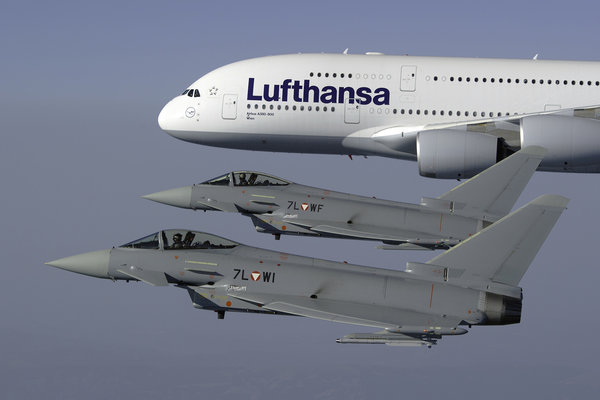Eurofighter Program Saved by Compromise Deal
The four nations involved in the Eurofighter Typhoon military aircraft consortium signed a long-awaited contract to buy more of the controversial fighter jets. The breakthrough represents a much-needed financial boost for a program central to European defense cooperation.
Eurofighter Program Saved by Compromise Deal
Soeren Kern | World Politics Review | September 8, 2009
The four nations involved in the Eurofighter Typhoon military aircraft consortium signed a long-awaited contract in late July to buy more of the controversial fighter jets. The breakthrough represents a much-needed financial boost for a program central to European defense cooperation, one that, like other European defense projects, has been dogged by technical problems and spiralling costs.
The $13 billion deal between Britain, Germany, Italy and Spain for another 112 Eurofighters followed many months of debate over the cost of keeping production lines open amid growing concerns over budgets and defense priorities.
Under the original Eurofighter umbrella contract signed in 1998, the founder nations agreed to buy a total of 620 of the jets, in three stages or tranches, through 2017. At the time, Britain agreed to take 232 of the 620 aircraft, with the rest split among Germany, Italy and Spain. The four countries divided work on the plane according to the number of aircraft each country planned to buy.
By the end of Tranche 2, the four partners still had 236 planes left to go, including 88 for Britain. But with a price tag of up to $140 million per piece, the British government, which is cutting back on defense spending, had initially refused to buy any more Eurofighters for cost reasons.
After bowing to pressure from German Chancellor Angela Merkel, who was worried about securing the future of the 100,000 jobs across Europe supported by the Eurofighter program, the partners agreed to a compromise by splitting Tranche 3 into two parts known as Tranches 3A and 3B.
Under Tranche 3A, Britain agreed to buy 40 planes, or just less than half of its remaining quota. Germany will get 31 Tranche 3A aircraft, Italy 21 and Spain 20. The deal, which brings to 559 the number of Eurofighters either in service (178) or on order (381), will keep the production lines open through 2015.
Left unresolved, however, are the details involving Tranche 3B, for which the partners hope to sign a contract by the end of 2011. The British Ministry of Defence has already ruled out the purchase of its final quota of 48 aircraft, which has fueled speculation that Tranche 3B may ultimately be abandoned.
The Eurofighter has long been the focus of criticism. Opponents say the airplane was conceived a quarter of a century ago to defeat what is now an obsolete Soviet threat. Originally designed to intercept Soviet bombers, the aircraft fails to meet today’s need for ground-attack aircraft to support front-line troops in modern wars against terrorists and insurgents.
Despite having spent more than $28 billion on the project over the last two decades, Britain will end up under the latest deal with only 40 Typhoons from the Tranche 3 group, which is technologically far superior to Tranche 1 and Tranche 2 models. Tranche 3 aircraft have been specially redesigned with precision ground-attack capabilities necessary for conflicts like the one in Afghanistan.
Critics also say the Tranche 3 aircraft, which will cost more than $140,000 per flight hour to operate, will not come into service until between 2015 and 2020, or one decade late. The British Royal Air Force (RAF) took delivery of its first quota of Eurofighter Typhoon jets in 2003. It is now trying to get its Tranche 2 Typhoons into Afghanistan, but is experiencing technical difficulties in converting them to a ground-attack role and does not have enough trained pilots. The Tranche 1 aircraft are not even able to carry cruise missiles because their undercarriage is too weak.
In Germany, the military top brass is also frustrated with the Eurofighter. In a scathing article, the German news magazine Der Spiegel reported that of the 38 Eurofighters the German air force now possesses, 14 have been sent back for repairs, and some of the aircraft still suffer instrument failure during flights: “Of the six single-seat aircraft at the Neuburg air base, only four are fit for service on average. That’s just enough to provide day and night cover for Germany’s airspace.”
Germany, too, has considered cutting back its purchases of the plane. In June, the German parliamentary defense committee said the country could not afford its full complement of 180 Eurofighters. It said Germany’s $21 billion investment would only be enough to pay for 143 Eurofighters, and that Parliament would have to approve an additional $4.2 billion if the air force was to get the planned 180 aircraft.
Faced with dwindling orders at home, the Eurofighter consortium now hopes it can keep the Typhoon alive by selling the aircraft abroad. In fact, it has set a goal of exporting 500 of the aircraft by 2020. But analysts say that goal is unrealistic, mainly because of the large number alternative fighter aircraft that are already on the export market.
At the moment, the Eurofighter consortium hopes that India will choose the Typhoon for its $11 billion tender for 126 combat jets. Eurofighter recently sweetened its deal by offering India an attractive manufacturing partnership.
But Eurofighter is facing stiff competition, with at least five other aircraft in the bidding race. Unless it can lower its price tag, the Eurofighter will be at a distinct disadvantage, costing almost twice as much as its main rival, Boeing’s F/A-18E/F Super Hornet.
As with other joint European defense projects, the Eurofighter is proving once again just how difficult it is to achieve true value for money on high-end weapons systems.
Soeren Kern is Senior Fellow for Transatlantic Relations at the Madrid-based Grupo de Estudios Estratégicos / Strategic Studies Group. Follow him on Facebook. Follow him on Twitter.
Originally published by World Politics Review on September 8, 2009.




